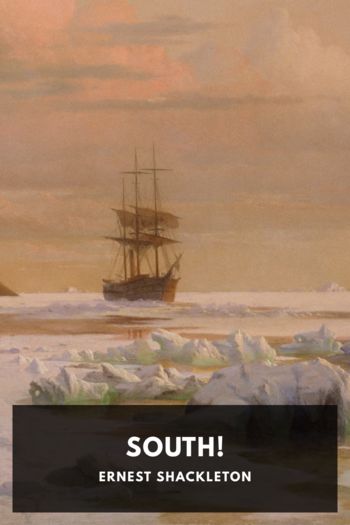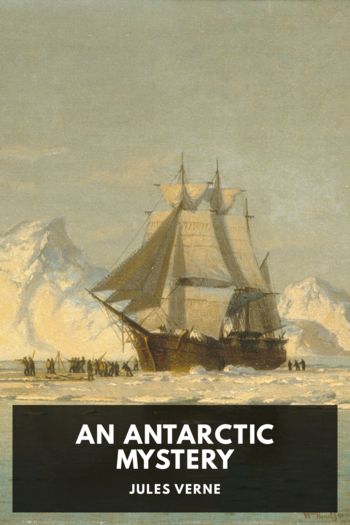South!, Ernest Shackleton [good books to read in english TXT] 📗

- Author: Ernest Shackleton
Book online «South!, Ernest Shackleton [good books to read in english TXT] 📗». Author Ernest Shackleton
The ice was not moving fast enough to be noticeable. In fact, the only way in which we could prove that we were moving at all was by noting the change of relative positions of the bergs around us, and, more definitely, by fixing our absolute latitude and longitude by observations of the sun. Otherwise, as far as actual visible drift was concerned, we might have been on dry land.
For the next few days we made good progress, drifting seven miles to the north on November 24 and another seven miles in the next forty-eight hours. We were all very pleased to know that although the wind was mainly southwest all this time, yet we had made very little easting. The land lay to the west, so had we drifted to the east we should have been taken right away to the centre of the entrance to the Weddell Sea, and our chances of finally reaching land would have been considerably lessened.
Our average rate of drift was slow, and many and varied were the calculations as to when we should reach the pack-edge. On December 12, 1915, one man wrote:
“Once across the Antarctic Circle, it will seem as if we are practically halfway home again; and it is just possible that with favourable winds we may cross the circle before the New Year. A drift of only three miles a day would do it, and we have often done that and more for periods of three or four weeks.
“We are now only 250 miles from Paulet Island, but too much to the east of it. We are approaching the latitudes in which we were at this time last year, on our way down. The ship left South Georgia just a year and a week ago, and reached this latitude four or five miles to the eastward of our present position on January 3, 1915, crossing the circle on New Year’s Eve.”
Thus, after a year’s incessant battle with the ice, we had returned, by many strange turns of fortune’s wheel, to almost identically the same latitude that we had left with such high hopes and aspirations twelve months previously; but under what different conditions now! Our ship crushed and lost, and we ourselves drifting on a piece of ice at the mercy of the winds. However, in spite of occasional setbacks due to unfavourable winds, our drift was in the main very satisfactory, and this went a long way towards keeping the men cheerful.
As the drift was mostly affected by the winds, the weather was closely watched by all, and Hussey, the meteorologist, was called upon to make forecasts every four hours, and some times more frequently than that. A meteorological screen, containing thermometers and a barograph, had been erected on a post frozen into the ice, and observations were taken every four hours. When we first left the ship the weather was cold and miserable, and altogether as unpropitious as it could possibly have been for our attempted march. Our first few days at Ocean Camp were passed under much the same conditions. At nights the temperature dropped to zero, with blinding snow and drift. One-hour watches were instituted, all hands taking their turn, and in such weather this job was no sinecure. The watchman had to be continually on the alert for cracks in the ice, or any sudden changes in the ice conditions, and also had to keep his eye on the dogs, who often became restless, fretful, and quarrelsome in the early hours of the morning. At the end of his hour he was very glad to crawl back into the comparative warmth of his frozen sleeping-bag.
On November 6 a dull, overcast day developed into a howling blizzard from the southwest, with snow and low drift. Only those who were compelled left the shelter of their tent. Deep drifts formed everywhere, burying sledges and provisions to a depth of two feet, and the snow piling up round the tents threatened to burst the thin fabric. The fine drift found its way in through the ventilator of the tent, which was accordingly plugged up with a spare sock.
This lasted for two days, when one man wrote:
“The blizzard continued through the morning, but cleared towards noon, and it was a beautiful evening; but we would far rather have the screeching blizzard with its searching drift and cold damp wind, for we drifted about eleven miles to the north during the night.”
For four days the fine weather continued, with gloriously warm, bright sun, but cold when standing still or in the shade. The temperature usually dropped below zero, but every opportunity was taken during these fine, sunny days to partially dry our sleeping-bags and other gear, which had become sodden through our body-heat having thawed the snow which had drifted in on to them during the blizzard. The bright sun seemed to put new heart into all.
The next day brought a northeasterly wind with the very high temperature of 27° F—only 5° below freezing.
“These high temperatures do not always represent the warmth which might be assumed from the thermometrical readings. They usually bring dull, overcast skies, with a raw, muggy, moisture-laden wind. The winds from the south, though colder, are nearly always coincident with sunny days and clear blue skies.”
The temperature still continued to rise, reaching 33° F on November 14. The thaw consequent upon these high temperatures was having a disastrous effect upon the surface of our camp.
“The surface is awful!—not slushy, but elusive. You step out gingerly. All is well for a few paces, then your foot suddenly sinks a couple of feet until it comes to a hard layer. You wade along in this way step by step, like a mudlark at Portsmouth





Comments (0)